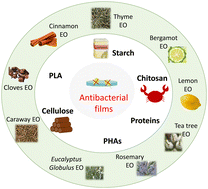Biobased polymer resources and essential oils: a green combination for antibacterial applications†
Abstract
To fight nosocomial infections, the excessive use of antibiotics has led to the emergence of multidrug-resistant microorganisms, which are now considered a relevant public health threat by the World Health Organization. To date, most antibacterial systems are based on the use of petro-sourced polymers, but the global supplies of these resources are depleting. Besides, silver NPs are widely accepted as the most active biocide against a wide range of bacterial strains but their toxicity is an issue. The growing interest in natural products has gained increasing interest in the last decade. Therefore, the design of functional antibacterial materials derived from biomass remains a significant challenge for the scientific community. Consequently, attention has shifted to naturally occurring substances such as essential oils (EOs), which are classified as Generally Recognized as Safe (GRAS). EOs can offer an alternative to the common antimicrobial agents as an inner solution or biocide agent to inhibit the resistance mechanism. Herein, this review not only aims at providing developments in the antibacterial modes of action of EOs against various bacterial strains and the recent advances in genomic and proteomic techniques for the elucidation of these mechanisms but also presents examples of biobased polymer resource-based EO materials and their antibacterial activities. Especially, we describe the antibacterial properties of biobased polymers, e.g. cellulose, starch, chitosan, PLA PHAs and proteins, associated with EOs (cinnamon (CEO), clove (CLEO), bergamot (BEO), ginger (GEO), lemongrass (LEO), caraway (CAEO), rosemary (REO), Eucalyptus globulus (EGEO), tea tree (TTEO), orange peel (OPEO) and apricot (Prunus armeniaca) kernel (AKEO) essential oils). Finally, we discuss the influence of EOs on the mechanical strength of bio-based materials.



 Please wait while we load your content...
Please wait while we load your content...